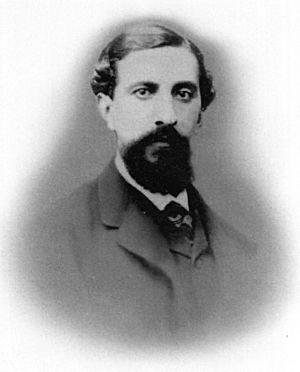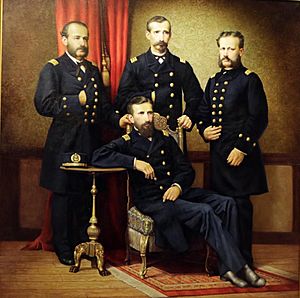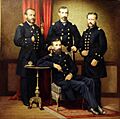Manuel Ferreyros facts for kids
Quick facts for kids
Manuel Ferreyros
|
|
|---|---|
 |
|
| Minister of Government, Police and Public Works | |
| In office April 13, 1869 – July 27, 1869 |
|
| Preceded by | Pedro Gálvez |
| Succeeded by | Rafael Velarde |
| Personal details | |
| Born | September 2, 1833 Lima, Peru |
| Died | January 13, 1876 (aged 42) Puno, Peru |
| Military service | |
| Allegiance | |
| Branch | |
| Years of service | 1854–1874 |
| Rank | |
| Battles/wars | Liberal Revolution (1854) Peruvian Civil War of 1856–1858 (WIA) |
Manuel José Ferreyros y Senra (born in Lima, Peru, on September 2, 1833 – died in Puno, Peru, on January 13, 1876) was an important Peruvian naval officer and politician.
Ferreyros was a close friend and fellow officer of Miguel Grau, Aurelio García, and Lizardo Montero. These four brave men were known as the Four Aces of the Peruvian Navy. Sadly, Ferreyros passed away early, three years before the War of the Pacific began. Because of this, he could not fight in that war like his friends. His younger brother, Captain Carlos Ferreyros, did fight in the war, commanding the Pilcomayo gunboat.
Contents
Manuel Ferreyros was born in Lima. His father, Manuel Bartolomé Ferreyros, was a politician and diplomat. Manuel joined the Peruvian Navy in 1853 as a midshipman, which is a junior officer rank. That same year, he sailed on the French ship La Forte, traveling to many islands in the Pacific Ocean.
Civil Wars and Promotions
When he returned to Peru in 1854, Ferreyros helped capture the city of Arica. He then served on the ship Almirante Guise. During the civil war of 1854, he stayed loyal to the government. After the war ended in 1855, he was briefly discharged but soon rejoined the navy.
In 1856, he became a second lieutenant. He was on the ship Apurímac when it rebelled in Arica in November 1856. This rebellion started a new civil war. Ferreyros did not join the rebels. He returned to Callao and defended the port. He was wounded in a battle on April 22, 1857. He was promoted to first lieutenant in June 1857.
Travels and the "Brave as Ferreyros" Saying
In 1857, Ferreyros traveled to Panama and then to Rio de Janeiro. He was meeting the ship Amazonas, which was returning from a trip around the world. He became the second commander of the Amazonas. In 1859, he helped blockade the coast of Ecuador during the Peruvian-Ecuadorian War. He was promoted again in October 1859.
In 1860, he went to England to help supervise the building of new ships for the Peruvian Amazon. In 1862, while on one of these ships, the Morona, he had a famous incident with Brazilian officials. They tried to stop him from passing Fort Ovidos in the Brazilian Amazon. Ferreyros insisted on passing, showing great courage. This event led to a popular saying in Peru: "as brave as Ferreyros" (Spanish: Bravo como Ferreyros). He then took command of the Loreto naval post. By this time, he was a captain.
Chincha Islands War and Later Career
In 1864, Ferreyros returned to Callao. He helped rescue the ship Callao (formerly Apurímac), which had sunk near San Lorenzo Island. From 1864 to 1865, he commanded the ship Loa.
In 1866, he fought in the Chincha Islands War. He commanded the corvette América. He was especially noted for his bravery in the Battle of Abtao on February 5, 1866. In this battle, the Peruvian-Chilean fleet fought against Spanish ships. His ship fired "the most accurate shots, with the longest range and most effect," according to the Spanish commander.
After the war, the Peruvian government hired an American officer to lead the navy. Many Peruvian officers, including Ferreyros and Grau, resigned in protest. They were arrested and put on trial but were later found innocent and released in 1867. Ferreyros then took a break from the navy and commanded a merchant ship, traveling to China.

Manuel Ferreyros and Lizardo Montero were godfathers at Miguel Grau's wedding in 1867. These four officers – Ferreyros, Grau, Montero, and Aurelio García y García – were often seen together. This is why they were known as the "four aces" in the navy.
Minister and Final Years
In January 1869, Ferreyros was promoted to captain. From April to July of that year, he served as the Minister of Government, Police and Public Works. He was part of President José Balta's government.
In July 1869, he sailed to Rio de Janeiro to bring two monitor ships, the Manco Cápac and the Atahualpa, from the United States to Peru. After returning to Callao, he became the General Commander of the Peruvian Navy on December 4, 1870.
In 1872, President Balta sent Ferreyros to Europe. His mission was to arrange the building of two armored ships and two gunboats for Peru. This was important because Chile was also building powerful new ships. However, President Balta's death in a coup interrupted Ferreyros's efforts. Peru was also facing an economic crisis, so they could only buy two gunboats: the Pilcomayo and the Chanchamayo. The Chanchamayo was lost in a shipwreck in 1876.
In 1874, Manuel Ferreyros retired from the navy due to health problems. He suffered a stroke and passed away early in 1876, at just 43 years old. Because of his early death, he could not fight in the War of the Pacific.
Family Life
Manuel Ferreyros was married to María Amalia Alayza y Portillo. They had three daughters: Elena, María, and Manuela.
He had two brothers who also served in the Navy:
- Carlos Ferreyros y Senra (1843–1910) was a brave officer during the naval campaign of the War of the Pacific. He served on the Pilcomayo gunboat.
- Eusebio Demetrio Ferreyros y Senra (1847–1868) served on the ship América. He sadly died in the Arica tsunami of 1868.
See also
 In Spanish: Manuel Ferreyros para niños
In Spanish: Manuel Ferreyros para niños
- Miguel Grau
- Lizardo Montero
- Aurelio García y García
Images for kids
-
The Four Aces of the Peruvian Navy. Standing, from left to right, Miguel Grau, Lizardo Montero and Aurelio García y García. Seated: Manuel Ferreyros.



